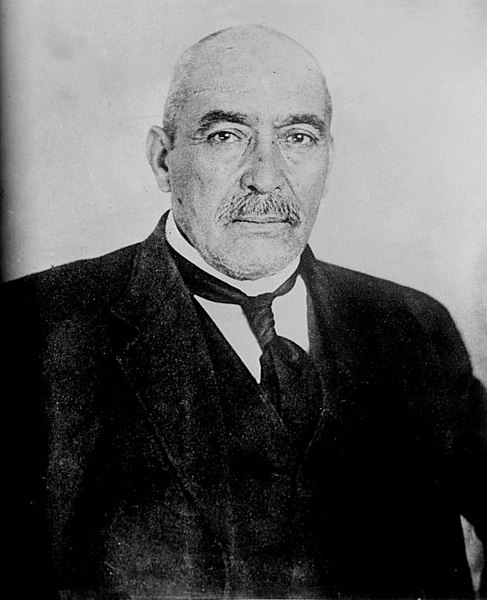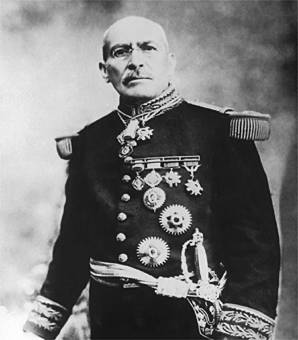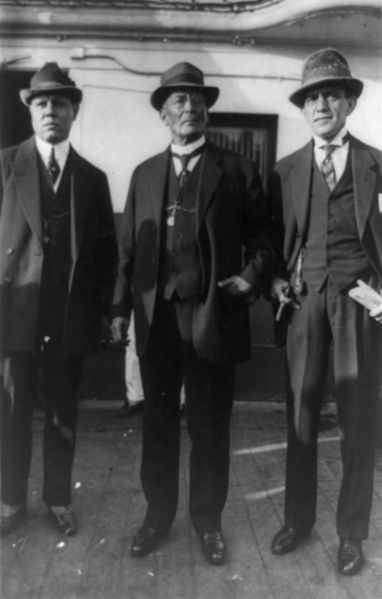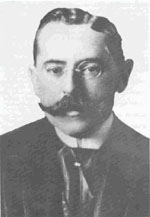<Back to Index>
- 35th President of Mexico José Victoriano Huerta Márquez, 1850
- 36th President of Mexico Francisco Sebastián Carvajal y Gual, 1870
PAGE SPONSOR



José Victoriano Huerta Márquez (23 December 1850 - 13 January 1916) was a Mexican military officer and president of Mexico. Huerta's supporters were known as Huertistas during the Mexican Revolution. Huerta is still vilified by modern day Mexicans, who generally refer to him as El Chacal ("The Jackal") or El Usurpador ("The Usurper").
Victoriano Huerta was born in the settlement of Agua Gorda within the municipality of Colotlán, Jalisco, son of Jesús Huerta and María Lázara del Refugio Márquez. He identified himself as indigenous, and historians have claimed that his father was ethnically Huichol. He learned to read and write early on and in 1869, he was recruited by General Donato Guerra to serve as his personal secretary. In that role, he distinguished himself; with the aid of General Guerra and President Benito Juárez, he gained admission to the Mexican National Military Academy (Heroico Colegio Militar) at Chapultepec in Mexico City in 1872.
Upon graduating from the military academy in 1877, he was employed by the Corps of Engineers to perform topographic studies in the states of Puebla and Veracruz, where he met Emilia Águila Moya, his future wife. He married Emilia Águila on 21 November 1880 in Mexico City. Together they had eleven children. The names of his children surviving him in 1916 were Jorge, Maria Elisa, Victor, Luz, Elena, Dagoberto, Eva and Celia.
During the Porfirio Díaz administration he rose to the rank of general, and fought to subdue the Chan Santa Cruz Maya peoples of the Yucatán and against the rebels of Emiliano Zapata. On the eve of the 1910 Revolution against the long established Díaz regime, Huerta was involved in the innocuous project of reforming the uniforms of the Federal Army.
After Díaz went into exile, Huerta initially pledged allegiance to the new administration of Francisco Madero, and he was retained by the Madero administration to crush anti - Madero revolts by rebel generals such as Pascual Orozco. However, Huerta secretly plotted with United States Ambassador to Mexico Henry Lane Wilson, cashiered general Bernardo Reyes, and Félix Díaz, Porfirio Díaz's nephew, to overthrow Madero. This episode in Mexican history is known as La decena trágica. Following a confused few days of fighting in Mexico City between loyalist and rebel factions of the Army, Huerta had Madero and vice president José María Pino Suárez seized and briefly imprisoned on 18 February 1913 in the National Palace. The conspirators then met at the U.S. Embassy to sign el Pacto de la Embajada (The Embassy Pact), which provided for the exile of Madero and Pino Suárez, and Huerta's takeover of the Mexican government.
To give the coup the appearance of legitimacy, Huerta had foreign minister Pedro Lascuráin assume the presidency; under the 1857 Constitution of Mexico, the foreign minister stood third in line for the presidency behind the vice president and attorney general; Madero's attorney general had also been ousted in the coup. Lascuráin then appointed Huerta as interior minister - constitutionally, fourth in line for the presidency. After less than an hour in office (some sources say as little as 15 minutes), Lascuráin resigned, handing the presidency to Huerta. At a late night special session of Congress surrounded by Huerta's troops, the legislators endorsed his assumption of power. Four days later Madero and Pino Suárez were taken from the National Palace to prison at night and shot by officers of the rurales (federal mounted police) who were assumed to be acting on Huerta's orders.
Huerta established a harsh military dictatorship. U.S. President Woodrow Wilson became hostile to the Huerta administration, recalled ambassador Henry Lane Wilson, and demanded Huerta step aside for democratic elections. When Huerta refused, and with the situation further exacerbated by the Tampico Affair, President Wilson landed U.S. troops to occupy Mexico's most important seaport, Veracruz.
The reaction to the Huerta usurpation was Venustiano Carranza's Plan of Guadalupe, which called for the creation of a Constitutional Army to oust Huerta and restore constitutional government. Supporters of the plan included Emiliano Zapata, Francisco "Pancho" Villa and Álvaro Obregón. After repeated field defeats of Huerta's Federal Army by Obregón and Villa, climaxing in the Battle of Zacatecas, Huerta bowed to pressure and resigned the presidency on 15 July 1914.
He went into exile, first traveling to Kingston, Jamaica, aboard the German cruiser SMS Dresden. From there, he moved to the UK, then Spain, and arrived in the United States in April 1915.
During 1915, he negotiated with Captain Franz von Rintelen of German Navy Intelligence for money to purchase weapons and arrange U-boat landings to provide support, while offering (perhaps as a bargaining chip) to make war on the U.S., which Germany hoped would end munitions supplies to the Allies. Their meetings, held at the Manhattan Hotel (as well as another New York hotel, "probably the Holland House" at Fifth Avenue and 30th Street) were observed by Secret Servicemen, and von Rintelen's telephone conversations were routinely intercepted and recorded.
Huerta traveled from New York by train towards El Paso, Texas, presumably to regain the Mexican presidency through a coup d'état. He was apprehended aboard his train in Newman, New Mexico, within 25 miles of El Paso, on 27 June 1915 together with Pascual Orozco and charged with conspiracy to violate U.S. neutrality laws. After some time in a U.S. Army prison at Fort Bliss, he was released on bail but remained under house arrest due to risk of flight to Mexico. Later he was returned to jail, and while so confined, died of cirrhosis of the liver.
Huerta has been portrayed or referenced in any number of movies dealing with the Mexican Revolution, including The Wild Bunch, Duck, You Sucker!, and And Starring Pancho Villa as Himself. In the 2008 film Indiana Jones and the Kingdom of the Crystal Skull, Jones recounts a tale from his youth of riding with Francisco "Pancho" Villa and spits on the ground as he says Huerta's name. In the film Villa Rides (1968), Huerta was portrayed by Herbert Lom.

Francisco Sebastián Carvajal y Gual (9 December 1870 - 20 September 1932) was a Mexican lawyer and politician who served briefly as president in 1914. In his role as foreign minister, he succeeded Victoriano Huerta as president upon the latter's resignation.
Born in 1870 in Campeche, Carvajal studied jurisprudence. He occupied important positions in the administration of President Porfirio Díaz. On 3 May 1911 Díaz named him as his representative at the peace conference with constitutionalist rebel Francisco I. Madero. In 1913, after Victoriano Huerta had seized power from Madero, Huerta named him president of the Supreme Court. Later (10 July 1914), Huerta named him to the cabinet as foreign minister. When Huerta resigned on 15 July, Carvajal was legally next - in - line to the presidency.
During his month-long presidential term, he oversaw the transfer of power to Venustiano Carranza and his Constitutionalist Army. Carvajal left office on 13 August 1914 and Carranza was sworn in the following 20 August.
Carvajal left for the United States. In New Orleans, he met and married Louise Martin. They had one child, Francisco Carvajal, on 19 October 1918. He returned to Mexico City in 1922 to take up his legal profession again and died there in 1932.